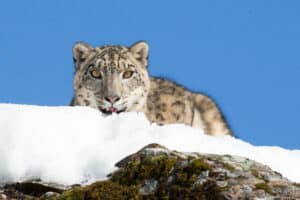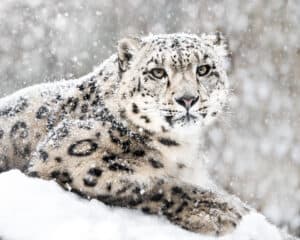When it comes to the world of big cats, the snow leopard stands apart as an enigmatic and lesser-known member of this formidable feline family.
Embark on a journey to compare and contrast the snow leopard with some of its more renowned relatives. Compare them to the lion, tiger, leopard, and jaguar in this article.
As we delve into their distinctive attributes, behaviors, and habitats, we’ll uncover what sets the “ghost of the mountains” apart from the more celebrated members of the big cat family.
Unravel the mysteries of these majestic creatures and explore the fascinating world of snow leopards in the context of their larger feline kin.
The Cats: Characteristics of The Big 5
When comparing snow leopards to other big cats, it’s essential to consider their size, physical characteristics, and habitat preferences as well as their prey and predators.
Lion (Panthera leo):

A group of lions is called a pride.
©Howard Darby/Shutterstock.com
Habitat: Lions, often referred to as the “kings of the jungle,” live primarily in the grasslands, savannas, and open woodlands of Africa. They form prides, social groups with a complex social structure.
Prey: Lions are apex predators, and their diet mainly consists of large herbivores like buffalo, wildebeest, zebras, and gazelles. Lionesses are the primary hunters.
Predators: Adult lions have few natural predators, although young cubs can fall prey to hyenas and leopards. However, when lions experience injuries or illness they quickly become targets for other large carnivores.
Interesting Facts:
- Lions are known for their distinctive manes, which males have more prominently. The mane serves as a symbol of strength and can deter rival males.
- Lions are one of the few big cat species that are truly social, living in prides. A pride can consist of multiple lionesses, their cubs, and a few dominant males.
- While often associated with Africa, lions once had a much wider range, including parts of Europe and Asia, but have significantly declined in numbers.
Tiger (Panthera tigris):
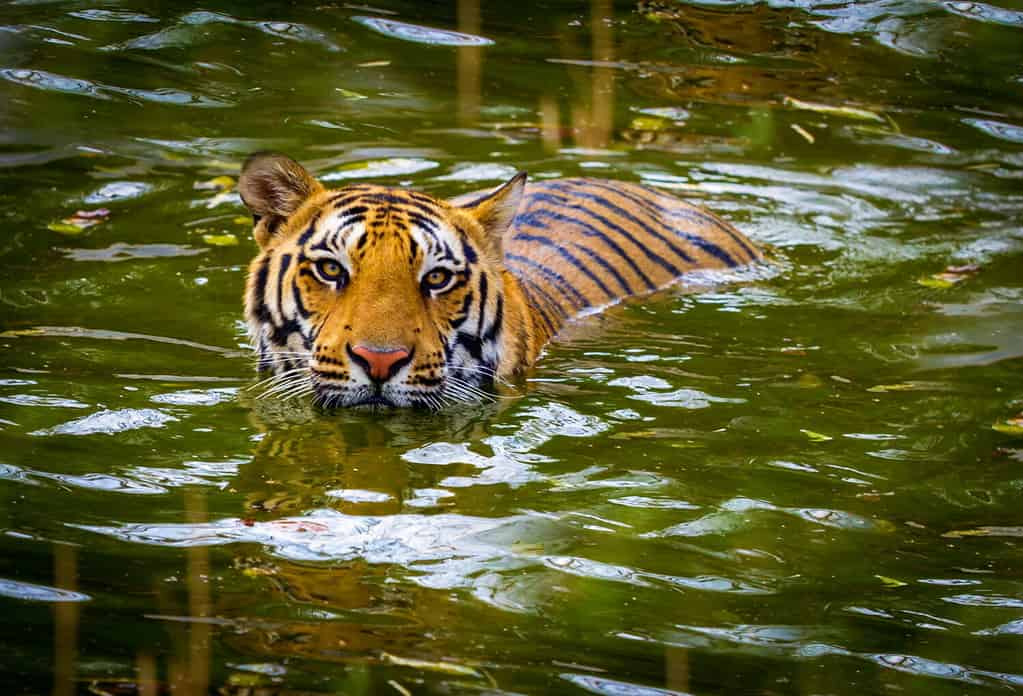
Tigers are known for their solitary nature.
©Glass and Nature/Shutterstock.com
Habitat: Tigers are native to Asia and inhabit a wide range of habitats, including forests, grasslands, mangrove swamps, and mountains. They are known for their solitary nature.
Prey: Tigers are formidable predators, preying on large herbivores like deer, wild boar, and antelope. They are known for their strength and agility when hunting.
Predators: Adult tigers have no natural predators, but tiger cubs can be vulnerable to attacks from other large carnivores.
Interesting Facts:
- Tigers are the largest of all big cat species, with the Siberian tiger being the largest subspecies. Tigers reach lengths of up to 12 feet.
- Unlike other big cats, tigers are known for their love of water and are excellent swimmers. They often cool off and bathe in lakes and streams.
- There are several subspecies of tigers. Sadly, many of these are endangered, with some on the brink of extinction due to habitat loss and poaching.
Leopard (Panthera pardus):

Leopards have one of the widest geographic ranges of any big cat.
©Reto Beuhler/Shutterstock.com
Habitat: Leopards are highly adaptable and can be found in a wide range of ecosystems, including forests, grasslands, and mountains. They are known for their solitary behavior.
Prey: Leopards have a diverse diet, including small mammals, birds, and larger prey such as deer and antelope. As skilled climbers, they often stash their kills in trees.
Predators: Leopards are not a common target for other large predators. However, they may occasionally have confrontations with lions or hyenas over food.
Interesting Facts:
- Leopards are known for their remarkable strength. They can carry prey larger than themselves into trees to protect it from scavengers.
- They are elusive and are often described as the “phantoms of the night” due to their nocturnal hunting habits.
- Leopards have one of the widest geographic ranges of any big cat. They mostly live across Africa and parts of Asia.
Jaguar (Panthera onca):
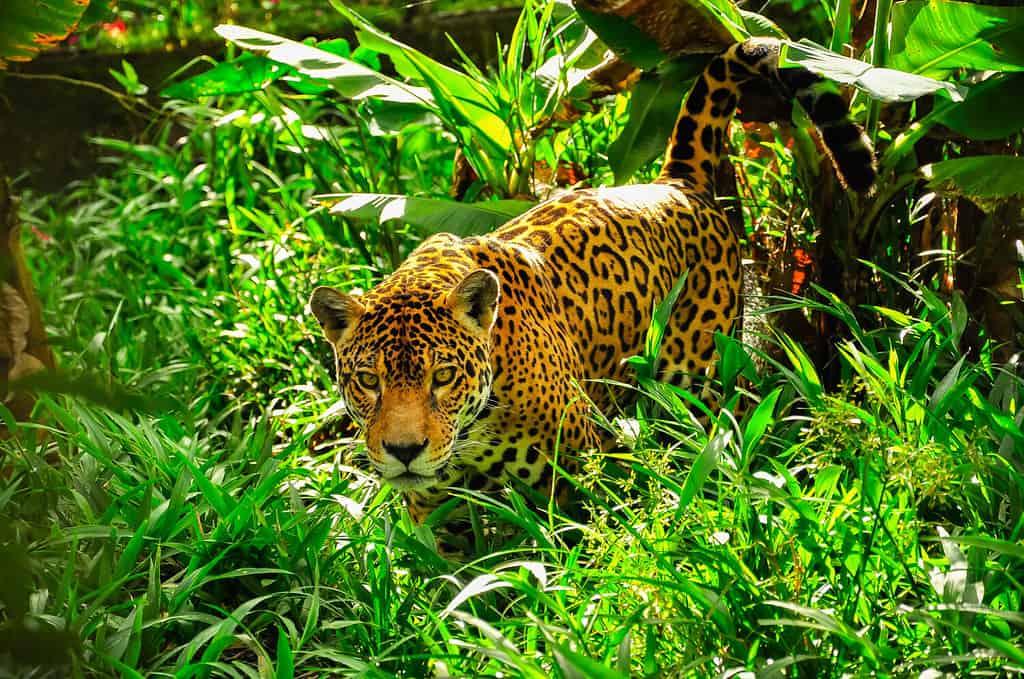
Jaguars typically inhabit rainforests, swamps, and grasslands.
©Jo Reason/Shutterstock.com
Habitat: Native to the Americas, Jaguars typically inhabit rainforests, swamps, and grasslands. They are solitary and elusive creatures.
Prey: Jaguars have a diverse diet, including large mammals like deer and peccaries, but they are also known to hunt smaller prey like birds, turtles, and fish.
Predators: Other large predators do not commonly prey upon Jaguars. However, Jaguars may encounter competition for food from other carnivores in their habitat.
Interesting Facts:
- The powerful jaguar bite is capable of piercing through the thick skulls or shells of their prey with ease.
- They have a distinctive rosette pattern on their fur, similar to leopards, but with smaller spots inside the rosettes.
- Jaguars are excellent swimmers and are known to hunt in the water. They love catching prey like caimans in rivers and streams.
Snow Leopard (Panthera uncia):
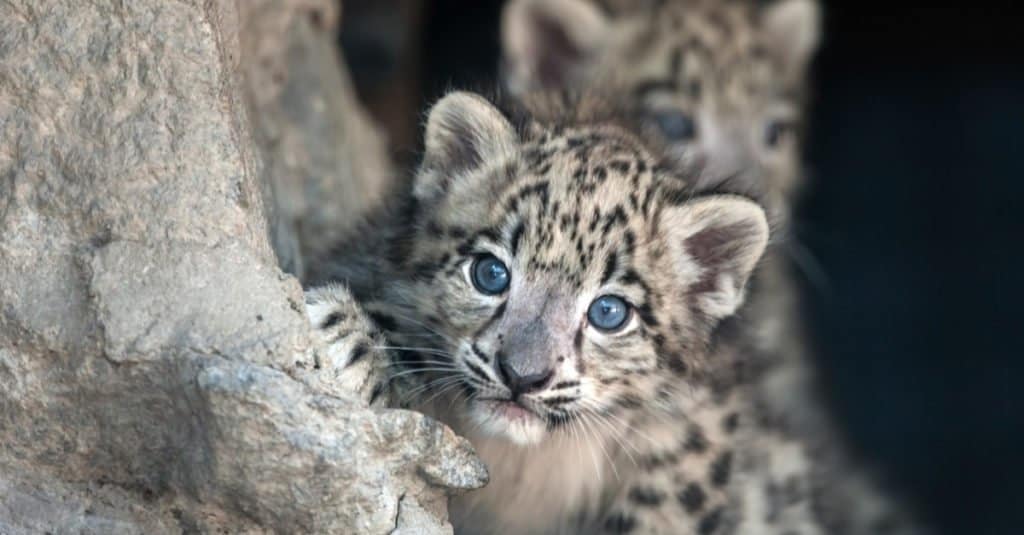
Snow
leopard
cubs may fall victim to larger predators such as wolves and even other snow leopards in territorial disputes.
©Kwadrat/Shutterstock.com
Habitat: Unlike their lion counterparts, Snow leopards are elusive feline predators that inhabit the cold and rugged mountainous regions of Central and South Asia. Their home ranges extend across 12 countries, including the Himalayas, Altai Mountains, and the Tibetan Plateau. They thrive at high altitudes, often living at elevations between 9,800 to 17,000 feet.
Prey: Snow leopards are opportunistic hunters, preying primarily on mountain ungulates such as blue sheep (bharal), ibex, and argali sheep. They also hunt smaller mammals like marmots, pikas, and birds. Their ability to stalk and ambush their prey is extraordinary, thanks to their agility and stealth.
Predators: Snow leopards are apex predators within their harsh mountainous habitats, and they have few natural enemies. However, when young cubs are vulnerable, they may fall victim to larger predators such as wolves and even other snow leopards in territorial disputes.
Interesting Facts:
- Snow leopards are known for their stunning, spotted fur coats. These coats provide camouflage in the rocky, snowy terrain and also act as efficient insulation against the cold. Their long, bushy tails help them balance on steep slopes. These tails also serve as a blanket to shield against extreme temperatures.
- Snow leopards lead a secretive lifestyle, with each individual having a large home range. Their encounters with other snow leopards are usually limited to mating or territorial disputes.
- Snow leopards possess well-developed chest muscles, which aid in breathing at high altitudes. Their large nasal cavities warm the frigid air they inhale. Their broad paws function like natural snowshoes to navigate treacherous terrain silently.
The snow leopard is a majestic and highly adapted big cat that thrives in the formidable mountain environments of Central and South Asia, facing unique challenges and requiring special attention for its conservation.
Each of these big cats possesses unique characteristics, habitats, and hunting strategies that make them remarkable apex predators in their respective ecosystems.
Side-by-side comparison
Here’s a table outlining the similarities and differences between snow leopards and some other prominent big cats:
| Attribute | Snow Leopard | Lion | Tiger | Leopard | Jaguar |
|---|---|---|---|---|---|
| Scientific Name | Panthera uncia | Panthera leo | Panthera tigris | Panthera pardus | Panthera onca |
| Average Weight (Adult) | 132-264 pounds | 330-550 pounds | 397-675 pounds | 66-198 pounds | 123-211 pounds |
| Length (Body + Tail) | 35-51 inches | 67-98 inches | 106-122 inches | 35-75 inches | 63-94 inches |
| Habitat Range | High mountainous regions of Central and South Asia | Grasslands, savannas, and open woodlands of Africa | Forests, grasslands, and mangrove swamps of Asia | Various ecosystems, including forests, grasslands, and mountains | Rainforests and swamps of the Americas |
| Coat Color and Pattern | Pale gray with black rosettes | Tawny with a mane in males | Orange with black stripes | Golden-yellow with black spots | Golden-yellow with black rosettes |
| Social Behavior | Mostly solitary | Social, living in prides | Mostly solitary | Mostly solitary | Mostly solitary |
| Prey | Mainly blue sheep, ibex | Large herbivores like buffalo and wildebeest | Large herbivores like deer and wild boar | A wide range of prey, including small mammals and birds | Large mammals like deer and peccaries |
Similarities:
- Size: Snow leopards are smaller than lions, tigers, and jaguars, but they are similar in size to leopards.
- Solitary Behavior: Like many other big cats, snow leopards are primarily solitary animals, coming together only for mating.
- Hunting Strategy: They are ambush predators, relying on stealth and surprise when hunting their prey.
- Camouflage: All these big cats have evolved some form of camouflage to help them blend into their respective habitats.
Differences:
- Habitat: Snow leopards are uniquely adapted to high-elevation mountainous regions, while lions, tigers, leopards, and jaguars inhabit a broader range of ecosystems.
- Coat Patterns: Each of these cats has distinctive coat patterns, with snow leopards having pale gray fur with black rosettes, while the others have different variations of spots, stripes, or solid colors.
- Social Behavior: Lions are known for their social behavior, living in prides, whereas the others are mostly solitary.
- Prey Preferences: Snow leopards primarily prey on mountain ungulates like blue sheep and ibex, while the other big cats have a more diverse diet that includes larger herbivores and various prey species.
There you have it – a quick comparison between several species of the big cat family.
The photo featured at the top of this post is © Warren Metcalf/Shutterstock.com
Thank you for reading! Have some feedback for us? Contact the AZ Animals editorial team.





